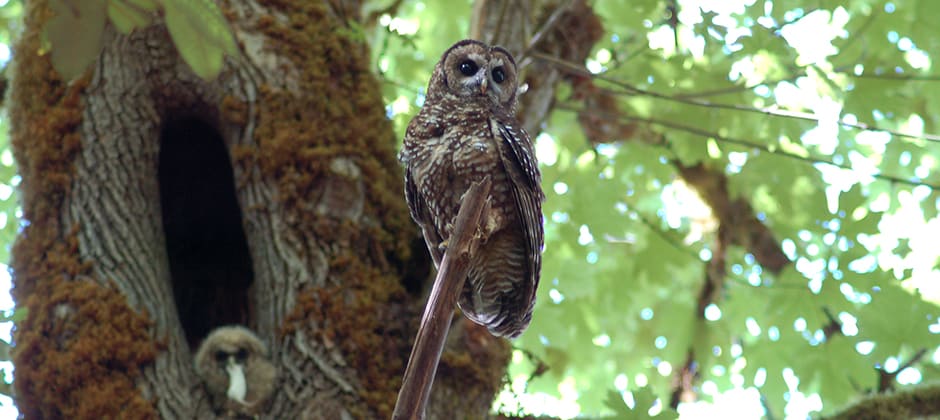Share this article
JWM: For spotted owls, missing the trees for the forest
Protecting remaining old growth forests won’t always conserve northern spotted owls, a team of researchers found. Instead, they say, managers may need to zoom in to finer scales to see how spotted owls use specific vegetative and topographic features in the forest. In some cases, too much old growth in a stand might actually be detrimental to the owl’s ability to capture prey, they found, and some forest thinning can be helpful.
“It isn’t enough to just say, ‘There’s old growth forest. There ought to be spotted owls,’” said Larry Irwin, a fellow with the National Council for Air and Stream Improvement, a nonprofit scientific organization that serves the forest product industry. Irwin is the lead author on the study published in the Journal of Wildlife Management. “You really have to look at the specific characteristics of the forest to see how well it meets the needs of spotted owls.”
Large, old trees certainly are important for northern spotted owls (Strix occidentalis caurina), Irwin said, but more of them isn’t always better. His team found what he calls “the Goldilocks paradigm.” While retaining too few trees in a stand can be harmful to the birds, he said, “no harvest may not be the best way to go, either.”
Irwin became interested in the idea back in the early 1990s when an interagency committee convened to develop a conservation strategy for protecting the species from the impacts of extensive logging in Northern California and the Pacific Northwest. Irwin, who worked on the committee report, suspected that the owls could exist in forests with some thinning, based upon their presence in forests that had been partially harvested in the past.
In this research, he and his team attached radio transmitters to spotted owls in eight study areas in Northern California and western Oregon — four where the birds faced competition from barred owls (Strix varia) and four with few or no barred owls. They found the spotted owls used specific characteristics of the forests and that barred owls affected where spotted owls foraged. Simply having old-growth trees wasn’t enough to predict where the spotted owls hunted for prey.
In population studies, “there certainly are correlations with old forest,” he said, “but sometimes the correlation was negative — quite opposite to what one would believe.”
Instead, they found that spotted owls choose certain tree species for foraging — of both conifers and hardwood — over others, and they preferentially use structures like snags, downed debris and shrubs. Creating spaces in the canopy, Irwin’s team found, can allow those shrubs and hardwoods to proliferate, benefitting the owls more than simply protecting the remaining large coniferous trees. In some managed California redwood forests, researchers found, habitat conditions seemed to discourage barred owls altogether, eliminating their competition with spotted owls.
“Retaining all old trees may not be a panacea for protecting spotted owls,” they wrote, “and not all nominally old forest should be considered for protection simply on the basis of density of large trees. The details matter greatly.”
This article features research that was published in a TWS peer-reviewed journal. Individual online access to all TWS journal articles is a benefit of membership. Join TWS now to read the latest in wildlife research.
Header Image: Recent research suggests some forest thinning could benefit northern spotted owls. ©Laurie Clark/NCASI








